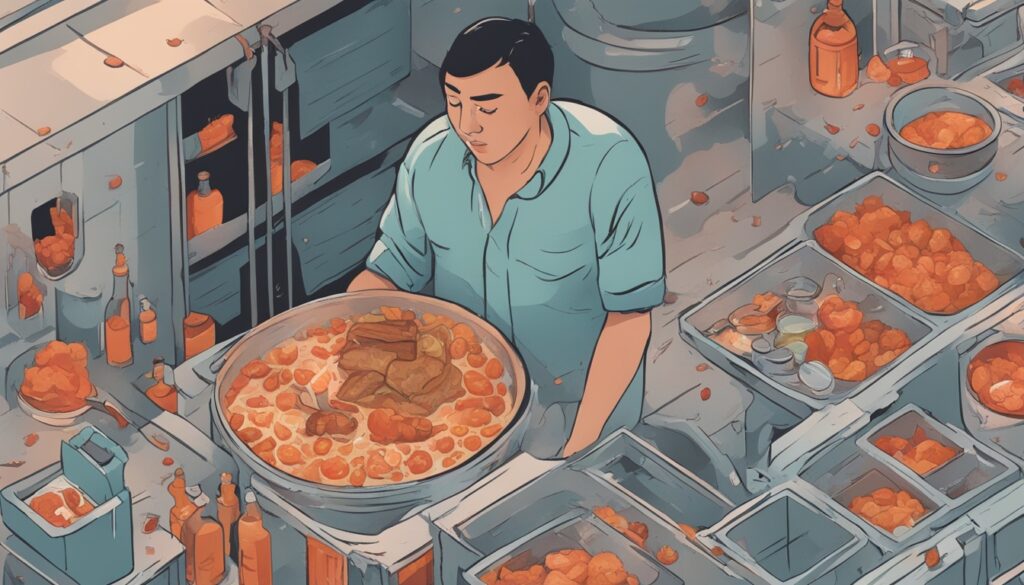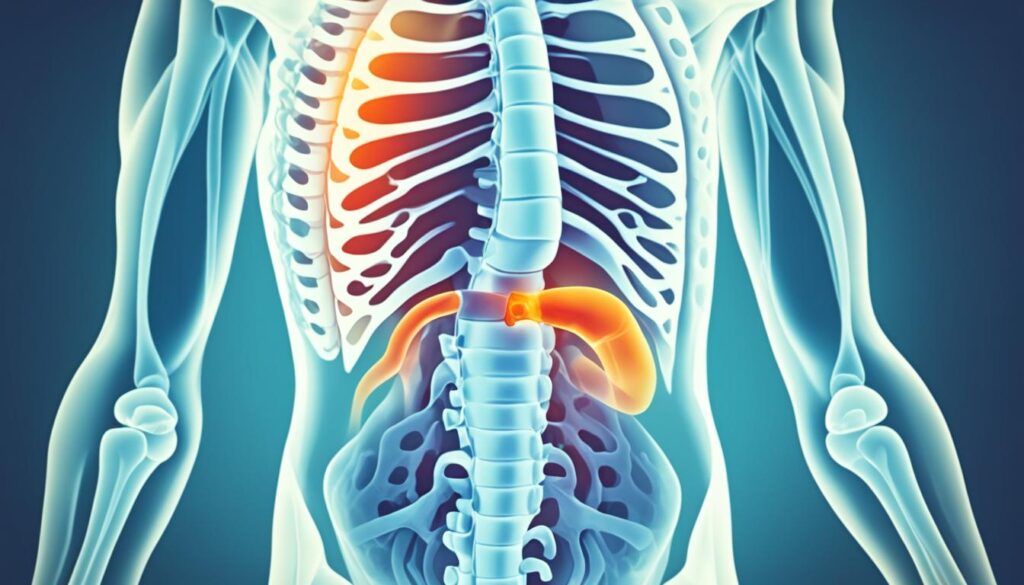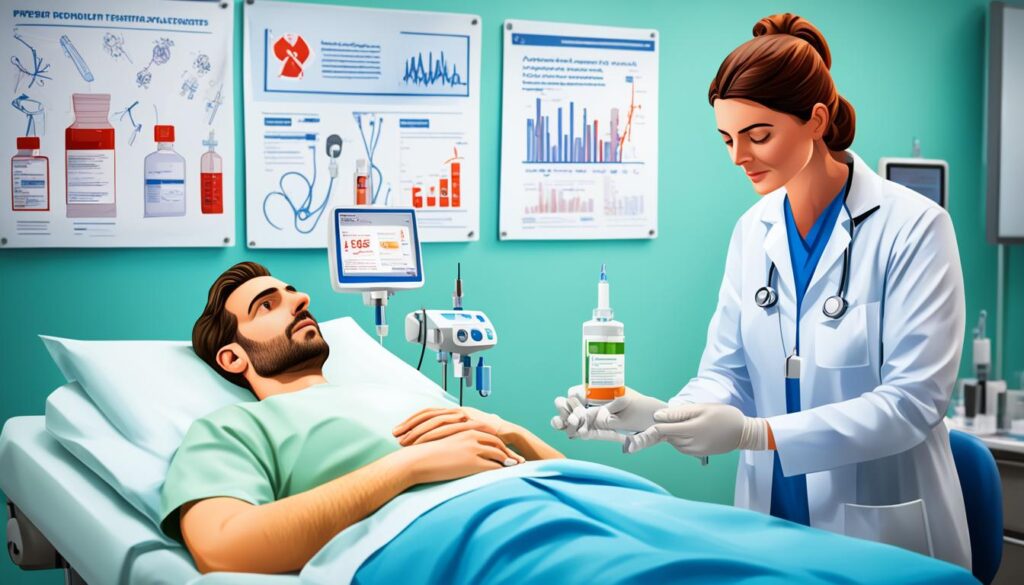|
Getting your Trinity Audio player ready... |
Typhoid fever is a severe infection led by Salmonella enterica bacteria. It’s found more often in areas like Africa, Latin America, and Asia. However, cases can show up in the U.S., usually affecting those who’ve traveled internationally. You catch typhoid fever by eating or drinking something contaminated. Then, the bacteria multiplies in your body and travels through your blood.
Table of Contents
ToggleIts symptoms usually start with a high fever and include feeling weak, stomach pain, headache, and not wanting to eat. Sometimes, it comes with a rash. If these signs sound familiar, getting medical help quickly is vital. A fast diagnosis and treatment for typhoid fever help avoid serious problems and dangers.
In the U.S., getting typhoid fever is rare, but the risks are real, especially if travel to high-risk areas is in your plans. Knowing the symptoms and when to get help can save your health. It also helps stop the disease from spreading further.
Understanding Typhoid Fever
Typhoid fever is a dangerous illness caused by the bacterium Salmonella Typhi. It is seen more in places without clean water, proper sanitation, and good hygiene habits. This illness can be passed on by contaminated food or water, and from one person to another.
What is Typhoid Fever?
It’s a big concern due to its severe symptoms, like a high fever and stomach pain. Sanitation and hygiene play a big role in preventing its spread, as the bacteria can easily get into food and water.
Causes of Typhoid Fever
Salmonella Typhi causes typhoid fever. People usually get it from eating or drinking something that’s contaminated. It can also spread between people, especially in places with poor hygiene and sanitation.
Transmission and Risk Factors
Traveling to certain places and being near sick people increases your risk. Many parts of Africa, Latin America, and Asia have higher chances of getting typhoid fever. Living in areas with poor hygiene or water access also makes you more likely to get the disease.

Typhoid Fever Symptoms
Typhoid fever symptoms start slowly, usually appearing 1 to 3 weeks after catching the bacteria. Early signs are high fever, chills, and a bad headache. You might feel very weak, with muscle pain and belly issues. Sometimes, you might see a rash.
If the sickness gets worse, it can cause more problems like bleeding in your stomach, not thinking clearly, or sepsis – a life-threatening condition. So, it’s super important to get diagnosed and treated early to avoid bad outcomes.
Early Warning Signs
The start of typhoid fever can be slow, and its signs tricky. At first, you might just feel like you’re catching a common bug. A rising temperature, up to a searing 104°F, marks the beginning for many. The higher the fever, the more you might shiver or feel cold. Headaches, constant tiredness, and achy muscles often join this mix. Some might also notice tummy troubles like pain or stomach issues.
Fever and Chills
Fever is a clear signal you might have typhoid fever. It quickly climbs to dangerous levels, making you feel colder than you are. A body temperature that hits 104°F (40°C) is not uncommon.
Headache and Fatigue
Typhoid fever headache is both relentless and severe. As this headache pounds, you may also feel terribly weak and drained. Muscles might ache too, early signs of the struggle your body is going through.
Gastrointestinal Discomfort
Feeling cramps, blocked up, or the opposite can signal typhoid fever early on. These stomach problems add to the challenge of spotting the illness. This is because they can easily be from something else.

Advanced Symptoms
As advanced typhoid fever takes hold, symptoms become more severe. A high fever that lasts a long time is a key sign. Often, you’ll also notice your belly is sore and swollen.
Without treatment, things can get really bad. You might see things like intestinal bleeding and sepsis. These aren’t just uncomfortable – they’re very dangerous. So, if you’re not feeling well, don’t wait. Go see a doctor right away.
Prolonged Fever
A feve that stays high (up to 104°F or 40°C) for weeks is serious. This means the illness is moving fast and needs treatment. So, if you’ve had a fever for a while, it’s time to get help.
Abdominal Pain and Swelling
Abdominal pain and bloating come from the bacteria spreading in your body. Your organs are getting damaged, which hurts a lot. This intense belly pain shows the illness is getting worse.
Complications and Life-Threatening Signs
Serious typhoid fever can cause really bad complications. It might lead to gut bleeding, a hole in the intestine, and even sepsis. These can be deadly. So, never ignore signs that your health is at risk.
Diagnosis and Testing
Your doctor will do some tests to check if you have typhoid fever. They will look at your blood and stool. This helps them find the Salmonella Typhi bacteria.
Blood Tests
Blood cultures are one type of blood test. They can show if the Salmonella Typhi bacteria are in your blood. This is important for confirming the infection.
Stool Sample Analysis
Along with blood tests, a stool sample might be needed. It looks for the bacteria in your stool. This test is another way to find out if you have typhoid fever.
Remember, these tests might not be accurate right away. Your doctor will look at your symptoms and where you’ve traveled too. These things help give the right diagnosis.

Treatment Options
The main treatment for typhoid fever is antibiotics. Doctors use drugs like ciprofloxacin or azithromycin. These medicines fight the bacteria causing typhoid, reducing how sick you get and for how long.
Antibiotic Therapy
Taking antibiotics is key in fighting typhoid fever. Most people feel better a few days after starting them. But, it takes up to 10 days to fully recover. It is crucial to finish the whole antibiotic course. This makes sure the bacteria are gone.
If you don’t treat typhoid fever with antibiotics, it can cause very serious problems.
Supportive Care
Besides antibiotics, supportive care is vital. It’s about handling fever and staying hydrated. Also, doctors treat any complications and suggest eating easy-to-digest foods. These include cooked veggies, fruits, refined grains, proteins, and low-fat dairy. This care, along with antibiotics, improves the chances of getting well soon.

Complications of Untreated Typhoid Fever
When not treated, typhoid fever can cause life-threatening problems. These include intestinal bleeding and perforation. Symptoms present as severe belly pain, throwing up, and spreading infection. It can lead to sepsis and organ failure too.
Intestinal Bleeding and Perforation
The severe impact of typhoid fever intestinal bleeding is internal gut bleeding. It brings intense stomach pain, vomiting, and the risk of deadly body-wide infections. Sometimes, the gut can tear, leading to a critical emergency needing fast surgery.
Sepsis and Organ Failure
When untreated, typhoid fever can advance to typhoid fever sepsis. This is a serious, full-body inflammatory response that may stop vital organ function. It can cause kidney issues, breathing problems, and even death. Swift diagnosis and the use of antibiotics are key to avoid these dangerous effects of typhoid fever.
Preventing Typhoid Fever
Keeping safe from typhoid fever is vital for you and your family. Luckily, there are many strong ways to avoid this dangerous sickness. This includes getting vaccinated, being careful with what you eat and drink, and taking care of your cleanliness.
Vaccination
If you plan to visit places where typhoid is a risk, vaccination is key. The CDC suggests you get the typhoid vaccine before visiting these places. In the US, you can choose between an oral or an injectable vaccine. The oral one is for people 6 and older, taken in 4 doses over 1 week. The injectable vaccine is a single shot for those 2 and up. Don’t forget, booster shots are needed to keep the vaccines working well.
Food and Water Safety
Avoiding unclean food and water is crucial in warding off typhoid. When in risky areas, only drink bottled or treated water. Stay away from unpeeled raw fruits and vegetables. Eating thoroughly cooked meals and drinking sealed, pasteurized milk reduces the chance of getting sick.
Hygiene and Sanitation
Good hygiene, like washing your hands often, can stop typhoid from spreading. If you don’t have soap and water, use hand sanitizer with 60% alcohol at least. Making sure clean water and hygiene are available is very important, especially in poorer countries.
Using all these prevention methods together can greatly lower your typhoid risk. This is true whether you’re visiting risky places or living there. Keep in mind, a mix of vaccination, being careful with food and water, and staying clean is the best protection against typhoid.
When to Seek Medical Attention
If you get symptoms of typhoid fever after traveling to a risky area, see a doctor quickly. This is important if you feel very hot, have bad stomach pain, feel confused, or have other bad signs. A quick diagnosis and treatment can stop life-threatening issues.
Your doctor might ask for blood or stool tests to check for typhoid fever. They will find the right antibiotics for you, if needed. Not treating typhoid fever can cause big problems like bleeding in your gut, sepsis, or organs not working.
If you’ve been to places where typhoid fever is common, like parts of Africa, Latin America, or Asia, watch for symptoms. Seek medical help right away. Treatment works well if it starts early. But not getting help fast enough can be very serious.
Typhoid Fever in Children
Typhoid fever affects people of all ages, especially kids. It’s most common in children between 5 and 9, especially in risky places. Kids may have fever, headache, and tummy troubles. These can be worse for young children.
Parents must act fast if they think their child has typhoid fever, especially after visiting risky places like Africa. Finding and treating it early can stop dangerous problems like bleeding or organ failure.
Even though typhoid fever is rare in the U.S., kids are at higher risk than adults. To prevent it, parents should teach kids to wash their hands a lot. They should also make sure food and water are safe, especially when going to risky areas.
Knowing the symptoms and risks of typhoid fever helps parents protect their children. With quick action and the right care, most children with typhoid fever get better without suffering serious harm.
Chronic Carriers and Public Health Concerns
After being treated, some who had typhoid fever may stay infected with Salmonella Typhi. These people, called typhoid fever carriers, don’t feel sick but keep releasing the bacteria in their waste. So, they could unknowingly pass on the illness to others. This is a major problem because these carriers might start outbreaks where they live.
To fight this, it’s key to keep things clean, avoid germs, and get tested often. This way, doctors and health experts can stop typhoid’s spread and keep more people from getting sick. Blocking the disease from moving through non-symptomatic carriers is vital to lower the disease’s impact worldwide, particularly in places where it’s more common.
Traveling and Typhoid Fever
Planning a trip to Asia, Africa, or Latin America? You must protect yourself from typhoid fever. This illness comes from the Salmonella Typhi bacteria. Travelers to risky places have a higher chance of getting sick.
Precautions for Travelers
To avoid typhoid fever, there are key steps for you. Here’s what to do before and during your journey:
- Get vaccinated – The typhoid fever travel precautions include getting a vaccine. Do this at least one month before you leave. The vaccine helps, but it’s not a guarantee against the illness.
- Avoid untreated water and raw produce – When it comes to typhoid fever travel, only drink bottled or treated water. Stay away from raw fruits and veggies that could be risky.
- Practice good hygiene – Washing your hands often is essential. Use soap and water, especially before meals. This step can stop the bacteria from spreading.
Seeking Medical Care Abroad
If typhoid fever symptoms show up while you’re abroad, act fast. Signs like a fever, headache, and tummy issues need attention. Knowing where to find good healthcare in the area is vital for quick, proper help.
Don’t forget to tell your local doctor, too, for advice and support. Early action and the right care can make a big difference.
Conclusion
Typhoid fever is very serious, and it can be deadly. It’s caused by the Salmonella Typhi bacteria. This disease is often found in places with poor health practices but can happen to travelers too. It starts with common symptoms like a high fever, headache, and feeling tired. These signs could be confused with other sicknesses, so finding out quickly and treating it is very important.
If left without treatment, typhoid fever can cause dangerous problems. It might lead to intestinal bleeding, sepsis, and the failure of some organs. The best way to handle this disease is by preventing it. This means getting vaccinated, eating safe foods, and drinking clean water are important. Having access to clean water and proper sanitation is crucial too. Research shows that using a protected well can lower the chances of getting typhoid fever by half.
Knowing about this disease helps everyone protect themselves. It’s important for people and doctors to share the responsibility of fighting typhoid fever. Over 9 million folks get sick with enteric fever yearly, and about 110,000 of them die. We all need to be aware and take steps to keep ourselves and our communities safe from typhoid.
FAQ
What is typhoid fever?
Typhoid fever is a serious illness caused by Salmonella Typhi. It’s found more in places with bad sanitation and hygiene. Yet, travelers can get it too.
What causes typhoid fever?
The sickness comes from the Salmonella Typhi bacteria. It spreads through bad food, water, or from person to person.
How is typhoid fever transmitted?
You can catch typhoid by eating or drinking something with the bacteria. It also spreads through close contact with an infected person who lacks proper hygiene.
What are the early symptoms of typhoid fever?
At first, you might feel fever, chill, headache, and very tired. You can also have muscle pain and trouble with your stomach like pains or bathroom habits.
How does typhoid fever progress?
As it gets worse, you might have a long-lasting fever and more stomach pain. Serious problems can happen like intestines bleeding, infections, or even organ failure.
How is typhoid fever diagnosed?
Doctors use blood tests and stool samples to check for the bacteria. This helps them see if you have typhoid fever.
How is typhoid fever treated?
The key treatment involves using antibiotics. Doctors also help manage symptoms and stop complications.
What happens if typhoid fever is left untreated?
Without treatment, it can lead to very bad things like gut bleeding, serious infections, or failure of organs.
How can typhoid fever be prevented?
Getting vaccinated is a good first step. But it’s also about being careful with food and water, washing hands, and using clean water and good waste management in risk places.
When should someone seek medical attention for typhoid fever?
If you feel typhoid fever symptoms, especially after being in a place where it’s common, see a doctor fast. This is crucial for swift and proper care.
Can typhoid fever affect children?
Yes, kids can get typhoid fever too. They might get the same symptoms as grown-ups and can also face severe effects.
What is a chronic typhoid fever carrier?
After getting better, a few people still carry the bacteria without feeling sick. They can infect others, leading to a big health concern.
What precautions should travelers take to prevent typhoid fever?
Before going to risky areas, get vaccinated and avoid risky food and drinks. Also, wash your hands well and know where to get good health care if you feel unwell.
Source Links
- https://www.mayoclinic.org/diseases-conditions/typhoid-fever/symptoms-causes/syc-20378661
- https://www.hopkinsmedicine.org/health/conditions-and-diseases/typhoid-fever
- https://my.clevelandclinic.org/health/diseases/17730-typhoid-fever
- https://www.webmd.com/a-to-z-guides/typhoid-fever
- https://www.ncbi.nlm.nih.gov/books/NBK557513/
- https://www.mountsinai.org/health-library/diseases-conditions/typhoid-fever
- https://www.cedars-sinai.org/health-library/diseases-and-conditions/t/typhoid-fever.html
- https://www.nhs.uk/conditions/typhoid-fever/treatment/
- https://www.cdc.gov/typhoid-fever/prevention/index.html
- https://wwwnc.cdc.gov/travel/diseases/typhoid


